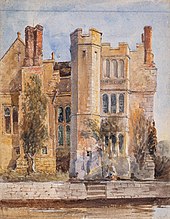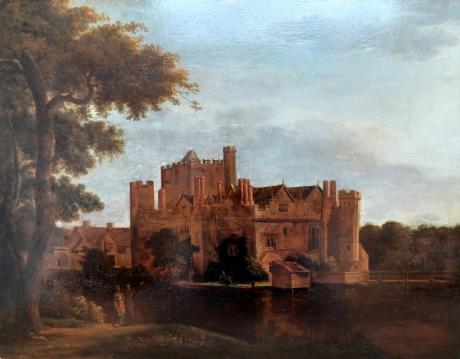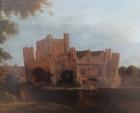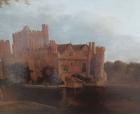Hever Castle is located in the village of Hever, Kent, near Edenbridge, 30 miles (48 km) south-east of London, England. It began as a country house, built in the 13th century. From 1462 to 1539, it was the seat of the Boleyn (originally 'Bullen') family.
Anne Boleyn, the second queen consort of King Henry VIII of England, spent her early youth there after her father, Thomas Boleyn, inherited it in 1505. The castle passed to him upon the death of his father, Sir William Boleyn. It later came into the possession of King Henry VIII's fourth wife, Anne of Cleves.
The Grade I listed castle is now owned by the Guthrie family's Broadland Properties.
History
There have been three main periods in the construction of this historic castle. The castle's oldest part dates to 1270 and consisted of the gatehouse and a walled bailey. It was then owned by James Fiennes, 1st Baron Saye and Sele. The second period was when the castle, then in need of repair, was converted into a manor in 1462 by Geoffrey Boleyn, younger brother of Thomas Boleyn, Master of Gonville Hall, Cambridge. He added a Tudor dwelling within the walls. The third period of repair and renovation was in the 20th century, when it was acquired by William Waldorf Astor.
Geoffrey Boleyn's grandson, Thomas Boleyn, inherited the castle in 1505. He lived there with his wife Lady Elizabeth Howard and their children George, Mary and Anne (the future wife of Henry VIII). It is not known if Anne was born at Hever (the year of her birth is not certain), but she lived there until she was sent to the Netherlands in 1513 to receive an education at the court of the Archduchess Margaret. Henry VIII often used the nearby Bolebroke Castle to conduct his courtship with Anne.
The property came into the possession of Henry VIII after the death of Anne's father, Thomas Boleyn, in 1539. He bestowed it upon Anne of Cleves in 1540 as part of the settlement following the annulment of their marriage. Hever Castle still has one of Henry VIII's private locks, taken with him on his various visits to noblemen's houses and fitted to every door for his security.

The property subsequently passed through various owners, including the Waldegrave family from 1557 to 1715, the Humfreys family to 1749 and the Meade-Waldo family from 1749 to 1903. During this latter period of ownership, the castle fell into a poor state of repair, during which time it was leased to various private tenants.
In 1903, it was acquired and restored by the American millionaire William Waldorf Astor, who used it as a family residence. He completed a restoration, added the Tudor village (also known as the Astor Wing) and also added the Italian Garden to display his collection of statuary and ornaments.
The castle has been Grade I listed since 10 September 1954; that was after the addition of the Tudor village, "a picturesque cluster of guest cottages".
In 1983, the Astor family sold the castle to John Guthrie (1906-1992), chairman of the family-run business, Broadland Properties Limited.
The castle was used as the location for music videos. The Loggia on the lake was used as the location for a peace conference in the comedy-drama The Great. Other productions that have filmed on the property include The Princess Bride and Inkheart.
Attractions for tourists
Hever Castle is now a tourist attraction, drawing on its links to Anne Boleyn and Henry VIII, its mazes, gardens and lakes. There is an annual event programme with assorted events, including jousting tournaments and archery displays in the summer months and an annual patchwork and quilting exhibition in September. The castle has also become the venue for a triathlon and open water swimming. The castle offers three floors containing antique furniture, Anne Boleyn's prayer books, instruments of torture, and a large collection of Tudor paintings. There is also a museum of the Kent and Sharpshooters Yeomanry.
The remains of the original country house timbers can still be seen within the stone walls of the fortification, while the gatehouse is the only original part of the castle. It has the oldest working original portcullis in England. The grounds of the castle include a yew maze, planted in 1904. There is also a water maze, opened in 1999, the object of which is to reach the folly at the centre without getting wet. In the children's adventure playground, there is a tower maze (currently undergoing reconstruction). The castle gardens contain a wide range of features, including an Italianate garden (including Fernery), rose gardens, herb garden, and topiary.
The castle can provide accommodation for visitors who wish to stay overnight, including 28 rooms that can be rented in a B&B format. Dining rooms for breakfast are available in both the Astor wing and Anne Boleyn wing. The castle also operates three restaurants, located in the gardens.
Gallery
George Lambert (1700 – 30 November 1765) was an English landscape artist and theatre scene painter. With Richard Wilson he is recognised as a pioneer of British landscape in art, for its own sake.
Life and work
Lambert was born in Kent and studied art under Warner Hassells and John Wootton, soon attracting attention by the quality of his landscape painting. He painted many large and fine landscapes in the style of Gaspar Poussin and Salvator Rosa. Many of his landscapes were finely engraved by François Vivares, James Mason (1710–1785), and others, including a set of views of Plymouth and Mount Edgcumbe (painted conjointly with Samuel Scott), a view of Saltwood Castle in Kent, another of Dover, and a landscape presented to the Foundling Hospital in London.
Lambert also obtained a great reputation as a scene-painter, working at first for the Lincoln's Inn Fields Theatre, in London, under John Rich. When Rich moved to Covent Garden Theatre, Lambert secured the assistance of Amigoni, and together they produced scenery of far higher quality than any previously executed.
Lambert was a man of jovial temperament and shrewd wit, and frequently spent his evenings at work in his painting-loft at Covent Garden Theatre, to which men of note in the fashionable or theatrical world resorted to share his supper of a beef-steak, freshly cooked on the spot. Out of these meetings arose the well-known "Beefsteak Club" which long maintained a high social reputation. Most of Lambert's scene-paintings unfortunately perished when Covent Garden Theatre was destroyed by fire in 1808.
Lambert was a friend of William Hogarth and a member of the jovial society that met at 'Old Slaughter's' Tavern in St Martin's Lane. In 1755 he was one of the committee of artists who proposed a royal academy of arts in London. He was a member of the Society of Artists of Great Britain, exhibited with them in 1761 and the three following years, and during the same period contributed to the Academy exhibitions. In 1765 he and other members seceded and formed the Incorporated Society of Artists of Great Britain, of which he was elected the first president.
In conjunction with Samuel Scott, Lambert painted a series of Indian views for the old East India House in Leadenhall Street. He also etched two prints after Salvator Rosa. Lambert was associated in 1735 with George Vertue, Hogarth, and John Pine (engraver, 1660–1756) in obtaining a bill from parliament securing artists a copyright on their works. Lambert's portraits were painted by Thomas Hudson, John Vanderbank (engraved in mezzotint by John Faber the younger in 1727, and in line by H. Robinson and others), and Hogarth.
Lambert's most famous painting is "A view of Box Hill, Surrey" (1733) which depicts a well-known beauty spot south of London. Hogarth considered Lambert a rival to the famous French landscape painter Claude Lorrain (1600–1682) with respect to his use of soft light to unify the scene in this painting. Though he never visited Italy he was inspired by the classical tradition of landscape painting.
Lambert died on 30 November 1765 at his home on the Piazza in Covent Garden.
His pupils included John Inigo Richards (1731–1810) and John Collett (1725–1780).
Gallery
-
A view of Box Hill, Surrey, 1733.
-
A Pastoral Landscape with Shepherds and their Flocks (1744).
-
View of Dunton Hall, Lincolnshire, 1739, possibly the earliest image of a Plot Elm (centre).

















![View of Dunton Hall, Lincolnshire, 1739, possibly the earliest image of a Plot Elm (centre).[4]](https://upload.wikimedia.org/wikipedia/commons/thumb/d/d7/George_Lambert_-_View_of_Dunton_Hall%2C_Lincolnshire_%281739%29.jpg/120px-George_Lambert_-_View_of_Dunton_Hall%2C_Lincolnshire_%281739%29.jpg)